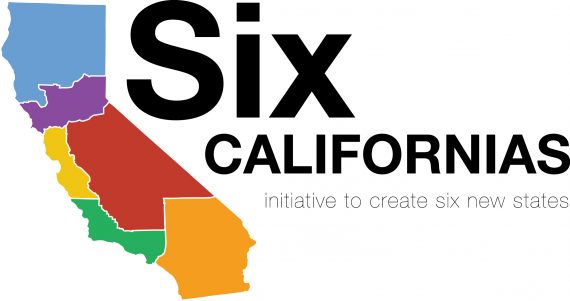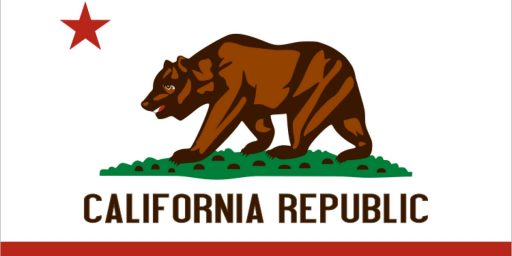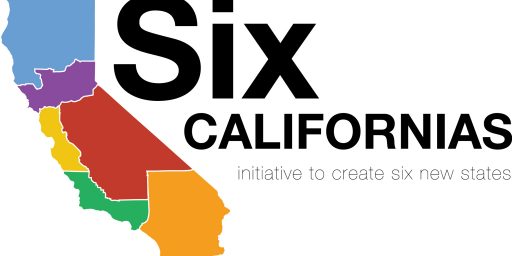Six Californias? It May Be On The Ballot In 2016, But It Probably Won’t Happen
A Silicon Valley businessman says he has enough signatures to get it on the ballot, but the plan to break California up into six states is most assuredly going nowhere.
Two years from now, the residents of America’s largest state could be voting on a referendum that would break California up into six separate states:
SAN FRANCISCO — A plan backed by venture capitalist Tim Draper to split California into six states has gained enough signatures to make the November 2016 ballot, the plan’s backers say.
A Twitter account belonging to the nonprofit Six Californias tweeted on Monday that “#SixCalifornias will be submitting signatures in Sacramento tomorrow for placement on the November 2016 ballot. Stay tuned for coverage!”
Roger Salazar, a spokesman for the campaign, said it’s gathered more than the approximately 808,000 signatures needed to place the measure on the ballot,Reuters reported.
Draper is a founding member of the venture capital firm Draper Fisher Jurvetsen, known for its investments in successful growth ventures such as Hotmail, Baidu, Tesla Motors and Skype. Recently, Draper won the federal government’s auction of bitcoins once owned by online drugs portal Silk Road. He’s championed the political break-up of the state for over a year, but it’s taken until recently for the plan to gain some momentum.
Draper and other supporters of the break-up argue that the state’s 38 million people would be better served by smaller governments and elected officials who would be able to work more closely with their constituents.
“If we have six Californias and we in effect dissolve the one we’ve got, those six allow us a new start,” Draper says in a video posted on the Six Californias website. Each state, which would have its own capital and legislature, would be able to write its own constitution.
The six carved out states would look like this:
- Jefferson: The northern part of the state, including Humboldt and Mendocino counties.
- North California: The wine country counties of Sonoma and Napa, as well as the Sierra Nevada region.
- Silicon Valley: Including San Francisco, San Jose and most of what’s considered the San Francisco Bay Area.
- Central California: The vast central valley farm region, including Tulare and Fresno counties.
- West California: Including Santa Barbara and Los Angeles.
- South California: Including what’s called the Inland Empire of San BernadinoK and Riverside, plus San Diego.
The plan has met with resistance from California’s Democratic majority, and a Field Poll found 59% of Californians surveyed were against the plan, according to the San Francisco Chronicle.
Here’s Draper’s video explaining his idea:
This isn’t the first time that there has been a proposal to split part of California apart. Tensions between the northern and southern parts of the state are long standing and have led to the idea of splitting the state apart, although few of them have gotten as far as this one has so far. The last real attempt was in the 1940s when six counties in Northern California attempted to team up with four counties in southern Oregon to form what would have been the state of Jefferson. The effort was really little more than a populist movement, and largely fizzled out after the Japanese attacked Pearl Harbor in 1941. Drapers plan to split the state into six separate entities has its roots in previous proposals to divide the state along geographic and cultural lines, but as Philip Bump note in his examination of what six California’s might look like politically and economically, the Draper plan is really all about making Silicon Valley and San Francisco Bay area its own state, a state that would obviously have access to a vast amount of wealth and talent that the more rural parts of the state in the north and Central Valley would not. Andrew Prokop, meanwhile, notes that the plan would simultaneously create both the richest (Silicon Valley) and poorest (Central California, which is a really dumb name for a state by the way) in the country. Indeed, as this analysis from Kathleen Miles shows, breaking California up into six states would basically go fine for Silicon Valley, North California, West California, and the area of South California around South California. The rest of the state wouldn’t fare so well. Left unaddressed in any of these discussions is the issue of how dividing the state up like this would impact the immensely important issue of the distribution of water throughout the state, and the question of just how willing the farmers of Central California are going to be to share water resources with the water-hungry areas around Los Angeles in West California. And that’s just one of the many issues that would likely come up if this plan actually came to fruition.
Before we get to the point of dealing with the consequences of breaking up California, there are a host of reasons why it likely isn’t going to happen, and why this referendum may not even make it on the ballot at all. As noted above, the most recent poll on this matter found that nearly 60% of Californians polled on the topic opposed the idea of breaking the state up as Draper proposes. Obviously, if the plan actually made it on the ballot there would likely be a huge campaign on both sides of the issue and those numbers may change, but given the fact that Silicon Valley is really the only region of the state that would benefit from the plan it seems difficult to imagine that there will be a huge groundswell of support to do something like this. In addition to this simple practical matter, though, there are also legal barriers to the plan that make the entire idea dubious at best. Election law expert Rick Hasan, for example, noted back in December that it may not be possible to do what Draper wants to do under state law, which makes it clear that revisions to the State Constitution cannot be the subject of a referendum, meaning that it would have to go through the state legislature. In addition to this state law issue, there is also the fact that Article IV, Section Three of the Constitution states that new states cannot be formed out of the territory of existing states without the consent of Congress and the legislature of the state in question. This language seems to make clear that a referendum would not be sufficient to carve up California in this manner and that the plan would still need to be approved by the California State Legislature, which would essentially be voting to vote itself out of existence, and by Congress. Even if the measure somehow managed to pass the legislature, which seems unlikely, it seems unlikely that Congress would approve the plan:
“This is the kind of thing that is not going to go over well, especially considering what it would mean for representation in the Senate,” said Richard Hasen, a law professor at UC Irvine. “It would multiply by six times California’s power in that body and putting aside partisan politics, it seems quite unlikely that you would get buy-in from the country to admit five new states into the union to magnify California’s power.”
So, in the end, there’s virtually no chance that there will be six Californias. Nonetheless, we may get to spend the next two years watching this issue play out.







Great, just what the country needs – 10 more Senators. But for the reasons you stated it isn’t going to happen.
Hey Tim, if you really want to create Draperstan, may I suggest you just do as Larry Ellison did and buy an island?
It’s a pity he didn’t have the courage of his convictions. Why name his pet new state “Silicon Valley” when it’s really meant to be Galt’s Gulch?
Rich guy thinks he pays too much in taxes; throws tantrum. Why doesn’t he just move to Florida?
A little less than half of California’s registered voters turn out to vote in a typical election. That’s right around a third of the voting age population and even less of the total population. My point here is that it doesn’t really matter if 60% of Californians oppose the division. What matters is what likely voters think and the poll tells us nothing about that.
Offhand I’d say that a small, determined minority could probably swing the proposition. That’s true of a lot of the California props and, arguably, the major weakness of the system.
That’s not to be construed as suggesting that I would support such a division. Just pointing out that it could happen.
@Dave Schuler:
That it could pass as a referendum is not the same as it could happen.
@OzarkHillbilly:
California’s proposition system is pretty powerful. If passed, the thing would undoubtedly end up in the courts. Whether it would make U. S. constitutional muster is another question. I seem to recall a provision that dividing states requires the approval of the state’s legislature.
Quite simply, this is Tim Draper’s plan to carve out 3 under-populated over-represented new Republican states our of one very Democratic California. Just what we need, more electoral influence for low population states.
The proposed 3 new Red States are very similar to ‘actual’ Southern Red States – they are the tax revenue beneficiaries of transfers of government resources from higher income Blue State regions of California.
As for Draper parroting the Republican claim that California is mismanaged because of Democrats – I would remind Draper that since Jerry Brown became governor, and we (the voters) repealed the legal requirement that a budget be passed with a supermajority vote (which enabled the GOP to block and delay passage of every state budget for over 20 years) that California has rebounded nicely, and is in fact running a surplus. This is due in some part to minimizing the deleterious effects of an unreasonable minority party (GOP) ability to obstruct governance.
I hope this doesn’t fizzle out before sparking a whole bunch of nutty equivalent secession movements in places like Idaho, Texas, and wherever. Entertainment for the next several years! (grabs popcorn.)
P.S. one of the reason the Quebec secession movement has never really gotten off the ground is because everyone knows if it were ever done, the Native Americans living north of the area would secede in turn….taking the hydropower electric dam with them that provides Montreal with all its power.
Article IV, Section Three of the Constitution states that new states cannot be formed out of the territory of existing states without the consent of Congress and the legislature of the state in question.
And yet, West Virginia was carved out of western Virginia without the approval of the Virginia House of Delegates. The federal government seems to be able to be able to take on extra-constitutional abilities when they wish.
@edmondo:
Then file a lawsuit against Lincoln.
@edmondo: “The federal government seems to be able to be able to take on extra-constitutional abilities when they wish”
Since this congress can’t manage to pass a highway bill, I’m really not too worried that they’ll come together on this.
@Surreal American:
Issa can investigate this while Boehner sues the Lincoln estate.
@edmondo:
You said that as though it were a bad thing.
@edmondo:
Technically, there was a rump Virginia legislature that met in Charleston that completed that task, but yea that’s been a sticking point for historians for 150 years. Of course, the fact that it happened in the middle of the Civil War and that Virginia never seriously challenged the secession of the mountain counties that became West Virginia after the war ended makes the point moot.
@Dave Schuler:
You may be correct but, of course, the referendum would be meaningless given the Constitutional requirements and quite possible void given the state law issues I noted in the post.
@edmondo:
There’s a not-as-crazy-as-it-sounds argument that “state legislature” includes any body authorized by state constitution to create law, which in California would include the voters in a referendum.
@edmondo:
Virginia House of Delegates shouldn’t have engaged in treason against the United States then….It’s a lot of chutzpah to complain about “extra-constitutional activities” of the US government after you’ve voted to illegally make war on that same government…..
Not to mention the question of whether any of the six new small states would have the necessary clout to continue appropriating water from Colorado and Arizona to feed their irrigation systems and sprawling cities…
He’ll get 20% of the vote, all from within 30 miles of Cupertino.
@DrDaveT: That’s an excellent point. @michael reynolds: That may be a bit low but I don’t think he will get the necessary votes but even if he does it will be held up in court for years and there is no way it would ever be approved by the US Congress. Tim Draper is channeling Don Quixote and tipping his hat at windmills. .
@DrDaveT: Huh? Six states with 12 senators and 38 million people carry less weight than one state with 2 senators and 38 million people?
@al-Ameda:
How do you get 3 Republican states out of that split? I count Jefferson, North, West, and Silicon Valley as all solid Democratic majorities with South and Central being Republican majorities. The differential would remain +2 Blue Senators.
@Pinky:
Each of those 6 states, well 3 of them anyway, would be vying for that water and they would still be competing against Nevada. A unified California has more economic muscle.
@Pinky: The problem is they will be fighting with each other while the entire agreement is renegotiated.
I think Pinky is right as far as the senate goes, but in the House the delegation would be solit in a way it isn’t now. Large states are screwed in the senate but benefit in the House.
@Grewgills: Jefferson is red.
Maybe they’ll compete with each other, maybe they won’t. I don’t see any obvious reason that Californians are entitled to a better bargaining position than Nevadans. Let the water find its own level, so to speak.
@Grewgills:
I count Jefferson as Republican. There is not much population up there, however where there are significant numbers (Redding, Eureka) the vote is Republican. I count South and Central as Republican too.
There would be enough competitive races that neither party can write off the plan on that front.
Small government conservatives, again, arguing for more government. While I’d appreciate being on more equal footing with Wyoming, I’ll still vote No if given the option.